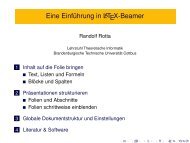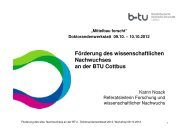Multilevel Graph Clustering with Density-Based Quality Measures
Multilevel Graph Clustering with Density-Based Quality Measures
Multilevel Graph Clustering with Density-Based Quality Measures
You also want an ePaper? Increase the reach of your titles
YUMPU automatically turns print PDFs into web optimized ePapers that Google loves.
3 The Multi-Level Refinement AlgorithmThis chapter presents the design of a family of algorithms for finding solutions tothe modularity clustering problem. The input is an undirected graph <strong>with</strong> weightededges and the algorithms search a clustering (partitioning) of the vertex set <strong>with</strong>high modularity. Finding clusterings <strong>with</strong> maximum modularity is known to be NPcomplete[13]. Therefore the presented algorithms are heuristics <strong>with</strong> polynomialbounded runtime and are unlikely to find global optima.Nowadays quite often agglomeration heuristics are employed for modularity clustering.These operate by successively merging adjacent clusters until the clusteringquality cannot be improved further. Most of them share one strong disadvantage:The merge decisions are based on insufficient local information but wrong decisionsare not corrected later.On the other hand refinement heuristics have the potential to correct these mergeerrors. In general refinement heuristics construct a neighborhood of problem solutionssimilar to the current solution and select the one <strong>with</strong> the best quality out ofthese. A situation in which all neighbor solutions have worse quality is called localoptimum. In the context of graph clustering the problem solutions are clusterings ofthe graph and local cluster refinement searches for clusterings <strong>with</strong> higher modularityby moving single vertices between clusters. Unfortunately all refinement methodsrequire an initial clustering and it is difficult to find good clusterings to start <strong>with</strong>.Furthermore refinement is not effective in huge graphs where each vertex has onlya tiny effect on the modularity. Many very small movements would be necessaryto walk in and out of local optima. This makes it very unlikely to find other localoptima by walking through a series of low-quality clusterings.Both refinement problems are tackled by the multi-level approach presented in thenext sections. It is based on the min-cut partitioning methods of Karypis [1] andbasically widens and accelerates the refinement search by moving whole groups ofvertices at once. These groups are constructed using agglomeration methods whichare presented the section about graph coarsening. They are similar to Newman’sgreedy joining [60, 15] but use other merge selection criteria. The fourth section exploresthe available refinement methods. Those are mostly derived from Kernighan,Lin, Fiduccia, and Mattheyses [45, 24] but are adapted to the dynamic number ofclusters present in modularity optimization. The employed local operations are summarizedin Figure 3.1. Merging clusters is exclusively used during graph coarsening.And during refinement vertex movements are applied. The last section completesthe chapter <strong>with</strong> additional insight into key concepts of the implementation.25






